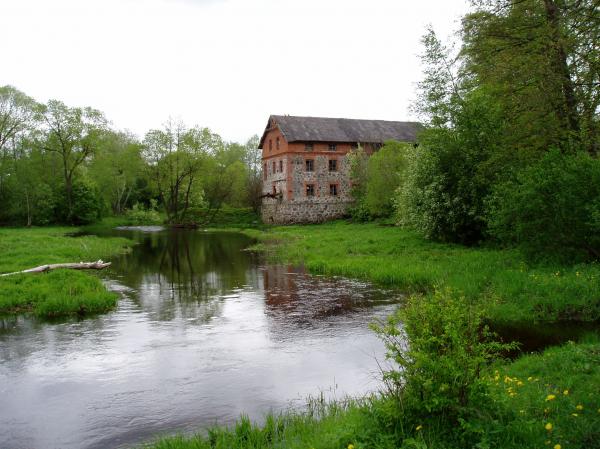Toliūnai Watermill
The old water mill of Toliūnai was already mentioned in 1857. It belonged to the Toliūnai private mansion. The wooden water mill stood on the River Lėvuo and it had only one millstone. In 1905, this old water mill burned down. It is supposed that the fire was caused by oil in the old equipment. In1908 Toliūnai mansion was bought by Mr. K. Balcevičius who started the construction of new brick water mill in 1909.
The new mill had three floors: in the upper floor, there were two millstones and in the lower, there were devices for spilling flour out into bags. In the western part, there were equipped three rooms for living and a kitchen. The millstones were used for bread making flour, for some special flour of the best quality and for groats. However, the Toliūnai mill was especially famous for its good rolls – a machine having two shafts rotating in opposite directions at different speeds. In the beginning, there were the porcelain mill shafts, but these were fragile and fell apart. The metal mill shafts replaced them.
Toliūnai estate owner Mr. K. Balsevičius bought various machines and all mill equipment. The Latvian engineers were invited for their installation and supervision.
From 1916 to 1917, Germans occupied the Toliūnai manor and its mill. The owner returned after the German invasion, but the mansion was devastated, so he decided to sell the mill. The Jews of Pakruojis and Žeimelis who did not live in Toliūnai, and hired local workers bought it. In 1927, the mill was sold to Mrs. Agnieszka Jasukevičienė, who came from the United States. She installed the wool-carding workshop in the west side, on the second floor, there were fleece the wool-carding workshop: there were two new machines: one for wool picking and the other for wick producing.
At that time Toliūnai water mill was as neat as a new pin and well-known not only in the neighbouring villages. The people would come even from Panevėžys to grind grain.
The wool-carding workshop was also profitable during several years. Two new machines, bought in Joniškėlis, were introduced, neatly maintained they satisfied the needs of local l farmers, but later became unprofitable, and that business was abandoned.
After the construction of the dam, the water energy turned into the rotary energy. The turntable was used, the water fell onto its top and filled its small troughs. Because of the water energy, a wheel rotated and whirled the machines inside. Later they began to use the turbine.
During the Soviet occupation, the mill owners often used to change.
Over time, the mill stopped working, nobody modify the dam and it has lost its meaning.
